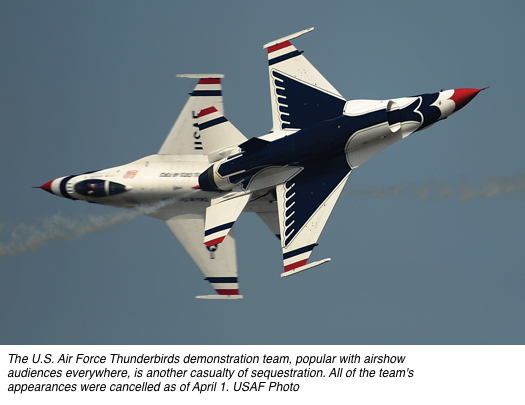Estimated reading time 6 minutes, 17 seconds.
It wasn’t supposed to happen. When U.S. federal lawmakers created the Budget Control Act (BCA) of 2011, they included a Draconian funding sequester provision that would kick in only if Con¬gress’ Joint Select Committee on Deficit Reduc¬tion (JSCDR) did not find $1.2 trillion of strategic spending cuts over a decade.
Few, if any, Americans thought that the so-called “super committee” would fail in its important mission. However, on Nov. 21, 2011, the JSCDR’s co-chairs announced that a bipartisan agree¬ment was not possible before the deadline. Their troubling statement started the countdown of the sequestration clock, with the massive funding penalty becoming law on March 1. Included in the cuts was a $500-billion reduction of funding for the Department of Defense (DoD), from 2013 to 2022. Critically, that penalty comes on top of a $487 billion DoD budget reduction over a decade that began last year.
It didn’t take long for the U.S. Air Force to announce that all appearances of the famous Thunderbirds aerial demonstration team were cancelled effective April 1. On April 9, the U.S. Navy sounded the death knell for its popular Blue Angels, axing the rest of the team’s 2013 performances.
Jennifer Elzea of the DoD’s press office told Canadian Skies that due to the funding sequester, “all aerial demonstrations, including fly-overs, jump team demonstrations, and participation in civilian airshows and military open houses ceased as of Apr. 1, 2013.”
Canadian airshows impacted
Canadian airshow producers who were counting on U.S. military participation in 2013 are scram¬bling to fill gaping holes in their show programs, and on their airport ramps.
“Initially, a lot of heads were in the sand, thinking it wouldn’t affect us,” said Dan McLaren, who oper¬ates Mach 1 Productions, which provides airshow sound and communications services at events throughout Canada and the U.S. “But it hit home once we knew we were going to lose all of our American fly-bys, our demos, our static line partici¬pation. The Canadian military is not that big, so we rely on our American friends to fill our ramps.”
McLaren said big shows will feel the loss the most, especially events such as the Abbotsford Airshow, which typically has one of the best aircraft static displays in the country. This year, only the Cana¬dian military and civilian acts will be on hand.
Jim Reith, the Abbotsford International Airshow Society’s new president, confirmed in a telephone interview in early April that the U.S. Air Force F-22 Raptor and other military assets would not be appearing at the 2013 show. “Nevertheless,” said Reith, “we have a terrific line-up of jet and propel¬ler aircraft, as well as crowd-pleasing ground displays for our six-hour show.”
A similar message came from the Canadian Inter¬national Air Show in Toronto, which reported that it will present another exciting show “with the sup¬port of the Canadian Forces and many civilian acts.”
McLaren said airshow organizers will need to get creative with this year’s programming. “Think out¬side of the box – include other things like motorcycle thrill shows and car shows,” he said. “Try to make it more of a festival so you’re not relying totally on aviation assets. You can also look at including corporate static aircraft, airliners, or warbirds.”
Some good news comes from a February poll con¬ducted by aviation site AVweb, where 55 per cent of respondents said they’d still go to their local airshow even if there were no jets. Another 24 per cent said that while they like jet acts, their decision to attend would be based on the lineup for the rest of the show. Only seven per cent said they’d skip the show entirely if military jets were absent.
In any case, this year will be critically important for Canadian airshows. They must find new and innovative ways to keep audiences happy so that they’ll return in 2014, when the U.S. acts will hopefully be back.
Canadian airshow organizers aren’t the only ones who are feeling the pinch this year. Twenty to 30 Canadians earn their livelihood from the airshow circuit, including acts, announcers, communica¬tions personnel like McLaren, and even air bosses.
“In order to make a living from it, you have to work in the U.S. to fill up your season. We don’t have enough shows here in Canada,” said McLaren, who typically handles sound services at 25 to 30 airshows per year. So far this year, he has lost five shows, with a couple more hanging in the balance. His season usually gets rolling in March, but this year McLaren doesn’t have any airshow work until June.
“From a cash flow standpoint, it makes it hard to stay in business,” he said. “I have concerns about where the U.S. industry is going.”
Without a doubt, a very different airshow season will be unfolding across Canada this year. A lot is riding on organizers’ abilities to build and promote entertaining programs without the traditional mili¬tary “big guns.” After all, the show must go on.

